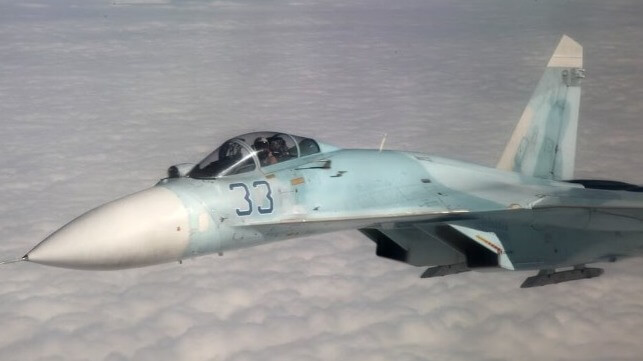Russian Fighters Force Down U.S. Drone Over the Black Sea

On Tuesday, the Pentagon reported that a U.S. military-operated MQ-9 Reaper drone was forced down in the Black Sea when a Russian fighter hit its propeller. The U.S. State Department described the incident as a "brazen violation of international law" and summoned the Russian ambassador to Washington, who denied that any physical contact occurred.
Early on Tuesday, the MQ-9 surveillance/attack drone was deployed on a routine flight in international airspace about 75 miles to the south of Crimea, a senior U.S. official told the New York Times. Though the drone aircraft is best known in its role as a lightweight ground-attack platform, its long loiter time and 50,000-foot service ceiling are optimal for surveillance, and its mission over the Black Sea is unarmed. Two Russian Su-27 fighter jets intercepted the slow-moving drone, and after flying past it at high speed, they repeatedly dumped fuel on it, according to the Pentagon. At about 0700, one of the jets struck the MQ-9's propeller, causing it to crash in the Black Sea.
"This unsafe and unprofessional act by the Russians nearly caused both aircraft to crash," said Air Force Gen. James B. Hecker, commander of U.S. Air Forces in Europe.
The Pentagon is currently going through its procedure to declassify images and video captured by the Reaper in its final moments. Pentagon spokesman Brig. Gen. Patrick Ryder told reporters that the video footage would support the American account of the run-in (if it is released).
Russia's Ministry of Defense issued a full-throated denial of the U.S. version of the events. “The Russian aircraft did not use on-board weapons, did not come into contact with the unmanned aerial vehicle, and returned safely to their home airfield," the ministry claimed.
Russia asserted that the area of the encounter was not in everyday international airspace, but rather a Russian-designated "temporary airspace regime established for the special military operation," the Kremlin's term for the invasion of Ukraine. The area has a high degree of sensitivity for Russia: the war has reached the Crimean peninsula and nearby waters on several occasions, including the sinking of the cruiser Moskva, the drone boat strike on Sevastopol and the attack on the Kerch Strait Bridge. The Russian Navy's Black Sea Fleet also uses the waters south of Crimea for launching guided-missile salvos at Ukrainian targets.
According to Samuel Charap, a fellow at the Rand Corporation, the run-in was consistent with past Russian "coercive signaling" behavior during NATO operations in sensitive locations.
"This is important because (based on historical patterns) the Russians would have had a clear military reason for what they did - this wasn't a random act of lashing out. And Russian pilots would have been following instructions from ground control, not freelancing," said Charap in a social media post. "It was an illegal and hugely dangerous action regardless, but past patterns can provide important insights about motives."
